The artist on Break
Quiet and
still
A tattered glove
lays in wait
for the fiery hand of
The Artist
This is how I feel today. Some days are for working. Some days are for patiently waiting.


The artist on Break
Quiet and
still
A tattered glove
lays in wait
for the fiery hand of
The Artist
This is how I feel today. Some days are for working. Some days are for patiently waiting.
6" x 7.5"
Handmade paints & 22k gold leaf on sheep skin
6" x7.5"
Handmade paints & 22k gold leaf on sheep skin
SOLD
6" x7.5"
Handmade paints & 22k gold leaf on sheep skin
SOLD
6" x7.5"
Handmade paints & 22k gold leaf on sheep skin
6" x 7.5"
Handmade paints & 22k gold leaf on sheep skin
6" x 7.5"
Handmade paints & 22k gold leaf on sheep skin
6" x7.5"
Handmade paints & 22k gold leaf on sheep skin
SOLD
4.5” x 4.5”
Handmade paints & 22k gold leaf on sheep skin
SOLD
6" x7.5"
Handmade paints & 22k gold leaf on sheep skin


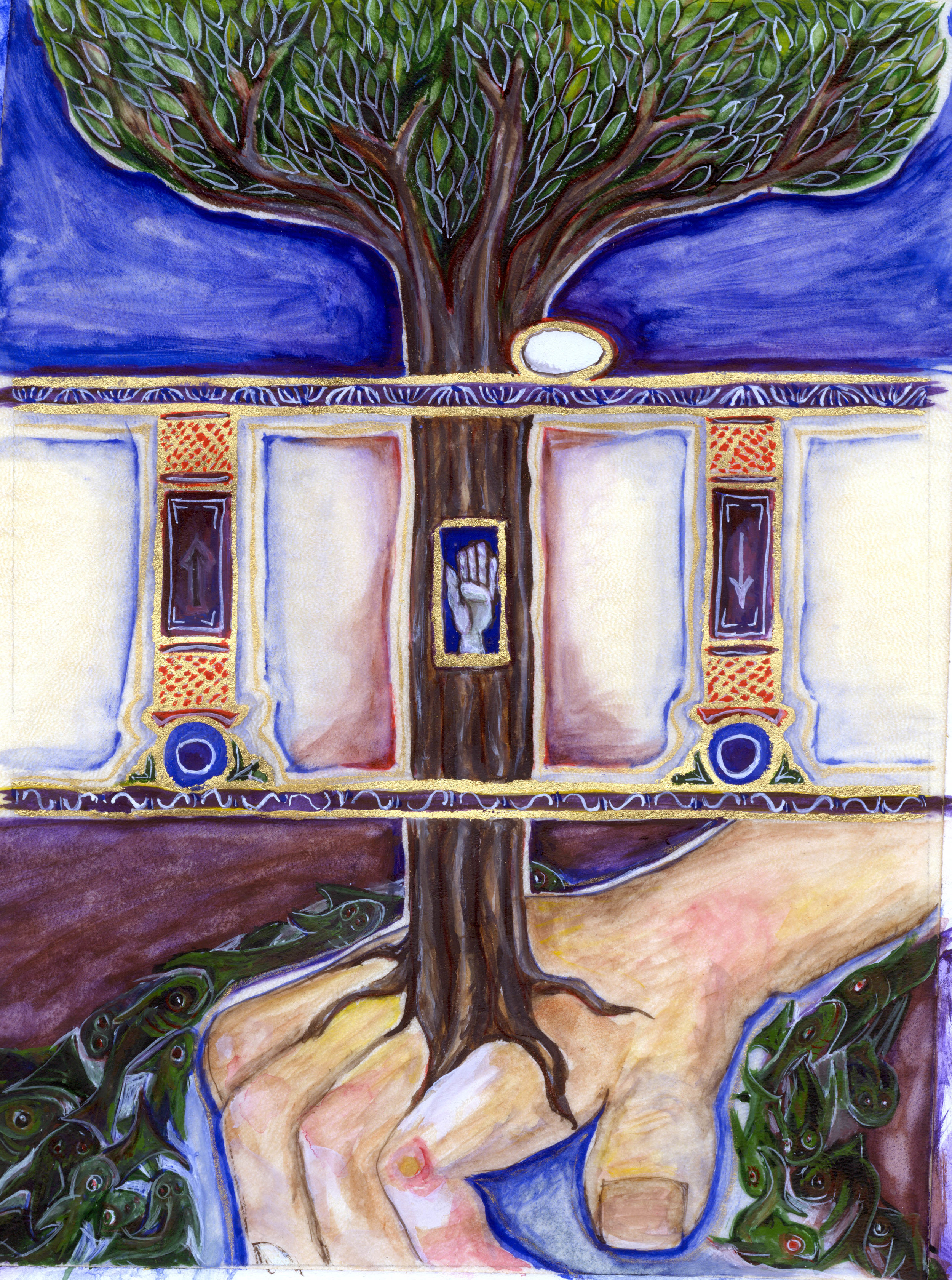
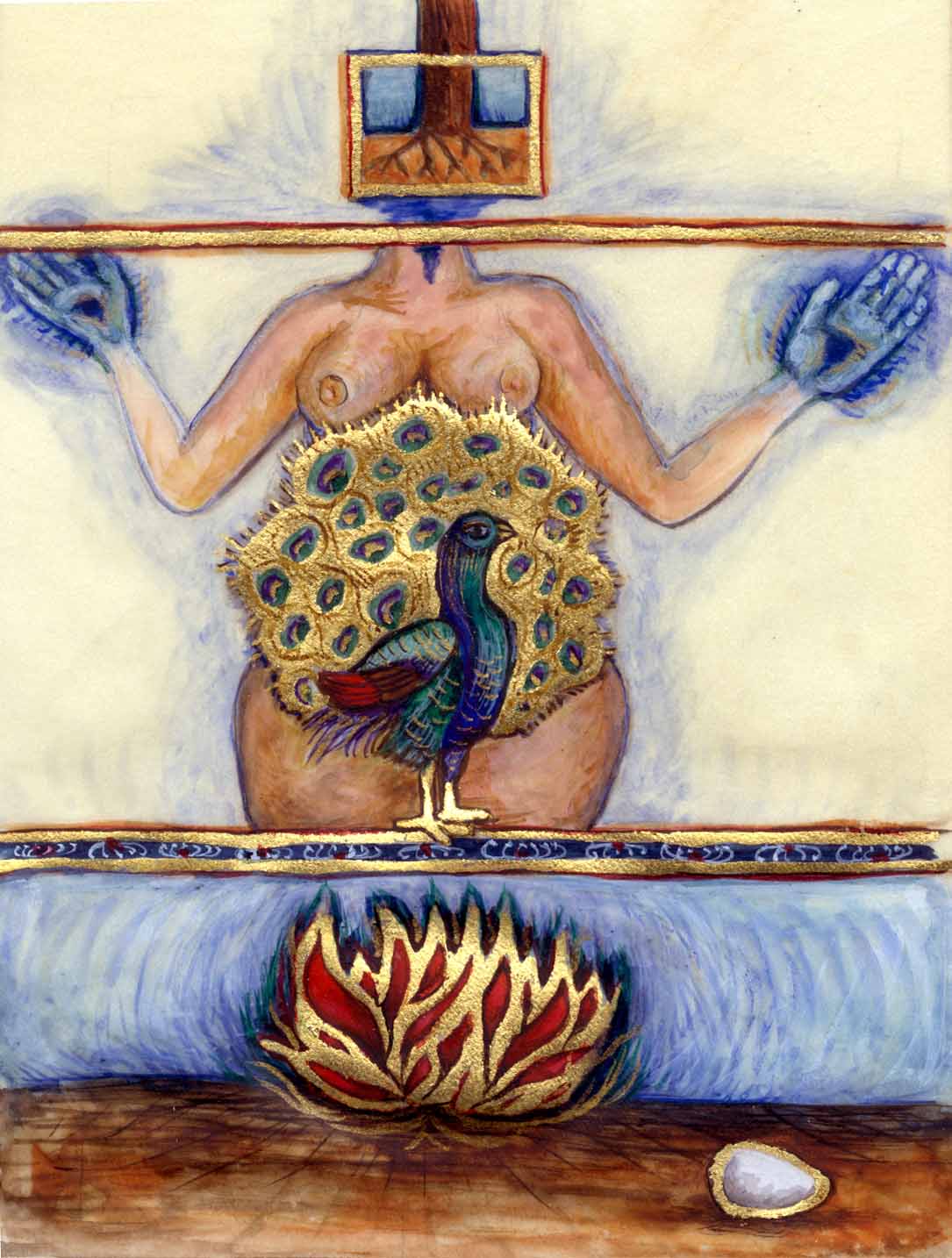

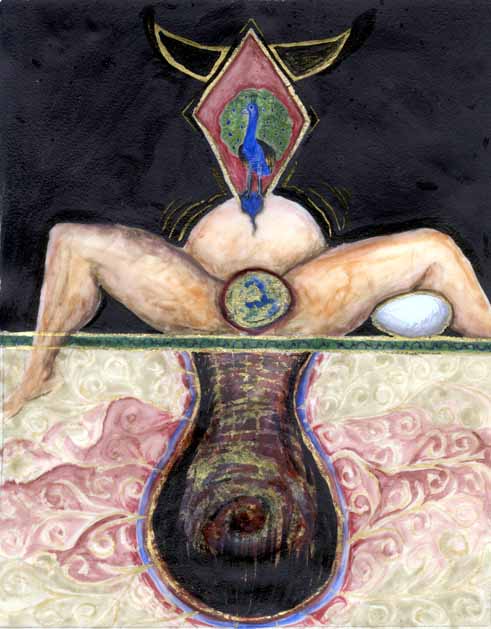
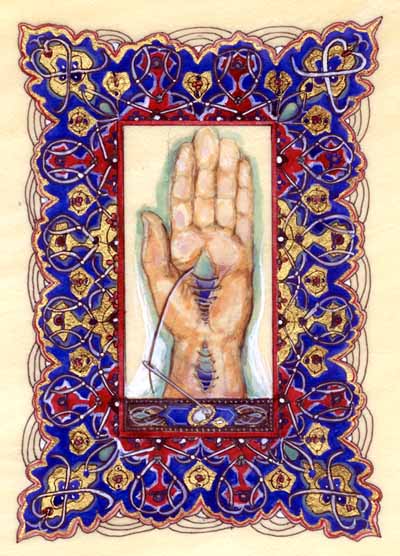
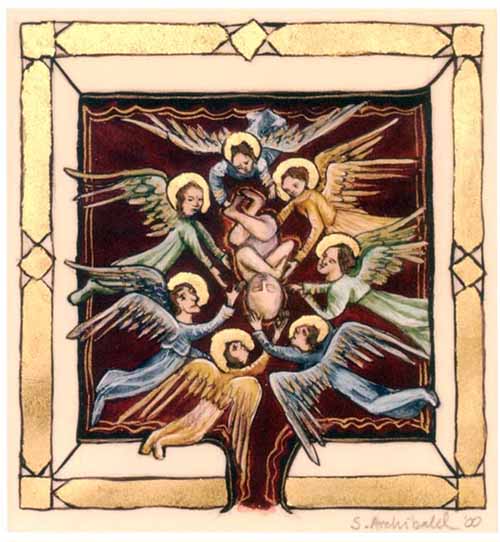
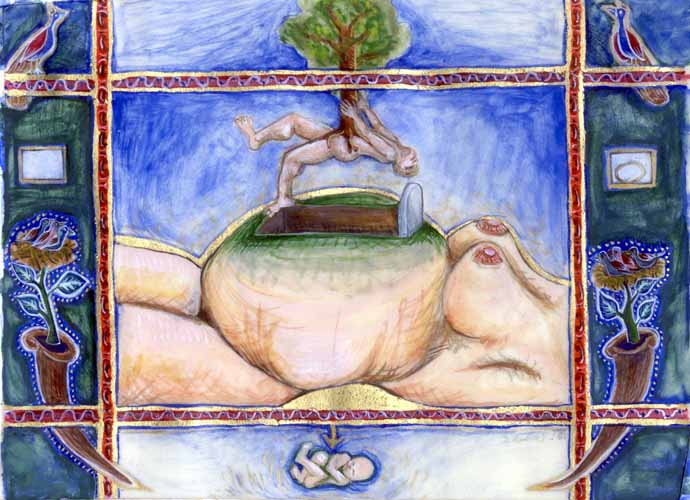
Illuminations by Sybil Archibald, 22k gold leaf and handmade paints on animal skin parchment
Over at Abbey of the Arts, Christine is holding a poetry party. She writes:
I invite you this week to write a poem about your own invitation to enter the refiner’s fire – in alchemy lead is transformed into gold through heat and this becomes a metaphor for the human soul. What is the lead within you ready to be transformed into something treasured?
I am not normally a poet but this topic is near and dear to my heart, so I was inspired. Over the years, I've made a deep study of early alchemists and their influence on medieval art techniques. The process of manuscript illumination is deeply sacred and transformative. My early embrace of these techniques allowed me to see that making art, regardless of medium, is a spiritual practice. Though I use many different mediums now, within me the spiritual crack opened by illumination continues to expand with Light.For more on the technique and meaning of illumination, see my posts Finding the Sacred in Contemporary Art and Lapis & Gold.
The Artist Illuminated
Parchment
I trace the lines of God
on this dead skin-a calf once, a self
prepared to be reborn.Gilding
The red clay of Adam
laying lifeless upon skin,
desiring yet empty.Deep within
I find it-Divine breath,
hot, filled with life.
Exhaling,I wake the glue which binds
body to soul,
giving form to life.
The once rough clay
is now perfected
by a blanket of gold.
With a flash the gilded clay rises up,
a wild horse running free,
as the newly golden surface
reflects living Light
back to Its
SourceMaking Paint
I crush azure blue from a stone like so many grapes
All the while
emptying
my frail body of care,
surrendering concern.
Bleeding madder root in a bubbling pot,
heating iron over a fire to red.
Finding within
this lifeless squid,
its precious gift:
warm and brown
sepia stains my palms.The Artist
Thus paint is made,
and my own skin emptied,
a self once,
prepared to be reborn.
Here in this moment I stand
an emptied vessel.
I dip my brush
and disappear.
I am the the glove
for the fiery blue Hand of the Artist
which destroys as it creates.
I have been consumed
In tender, burning flame
a shell of my former self
all ashes, all dust
which I collect and slowly
begin to grind into paint.
-Sybil Archibald
Clays are extraordinary, layered, crystal structures which have, built into them, what amounts almost to an innate tendency to evolve...Clay has plans.-Lyall Watson, from An Introduction to Clay Colloid Chemistry

I started as an artist at the age of 6 in clay. The altars (images below) I built from clay I dug directly out of the earth are some of the most satisfying pieces of my career. There is an innate connection between God and earth. Clay is a meeting place, a doorway to Heaven.I have been an avid gardener for years. I began to garden for the fragrance and color of flowers but now I garden for soil. It is easy to miss the Divine is the humble trappings of dirt. There is something about soil that is just afire with the light of God. It is the lowliest of things, we tread on it, ignore it, sweep it away, and yet it sustains us all. The soil pulses with life that we cannot or will not see. There is no more satisfying feeling than seeing what appears to be a barren, wormless plot of land transform into a teaming mecca of life.
Working with clay gives me the same satisfaction. Clay itself is very dense, like the material word itself. It takes effort to move it and to see in it the true reflection of the Divine. And yet it is responsive. There is something in clay that wants to grow and transform and which responds to that same impulse within the artist. Clay is a partner in the creative act, not a submissive servant.In the biblical story of the creation of man, God chooses to blow the breath of life into clay to create Adam. I have discussed this from the perspective of the gilder who must use breath, but the clay’s perspective is just as interesting.
That God chose clay to receive his direct kiss, should illuminate the central importance of Earth. By gardening or working with clay we engage the Earth. And if we empty ourselves and enter fully into the present moment something amazing happens. The artist becomes the physical vessel for Divine creative energy, holding it, that it may be translated into, fused with matter. The particular way in which an artist engages matter allows for greater concentrations of Macrocosmic energy to enter the world.But that is not all. All matter, to a greater or lesser degree has consciousness of its Source. Clay is like a sponge that actively seeks to draw in Divine fecund energy. It and Earth itself has its own active spirituality and deep connection to God.Contemporary theologian Thomas Berry argues this persuasively.
There is a spiritual capacity in carbon as there is a carbon component functioning in our highest spiritual experience. If some scientists consider that all this is merely a material process, then what they call matter, I call mind, soul, spirit, or consciousness. Possibly it is a question of terminology, since scientists too on occasion use terms that express awe and mystery. Most often, perhaps, they use the expression that some of the natural forms they encounter seem to be "telling them something".- Thomas Berry, The Great Work: Our Way into the Future, Page: 25
He also says:
“Gardening is an active participation in the deepest mysteries of the universe.”
Medieval theologian St. Thomas Aquinas wrote that
All things love God. All things are united according to friendship to each other and to God.
And mystics such as Teilhard de Chardin and Hildegard of Bingen see it everywhere:
Crimson gleams of Matter, gliding imperceptibly into thegold of Spirit, ultimately to become transformed into theincandescence of a universe that is person- and through all of this there blows, animating it and spreading over it a fragrant balm, a zephyr of union- and of the Feminine.The diaphany of the Divine at the heart of a glowing universe, as I have experienced it through contact with the earth- the divine radiating from depths of blazing matter.-Teilhard de Chardin
Hildegard of Bingen says:
God’s Word is in all creation, visible and invisible. The WORD is living, being, spirit, all verdant greening, all creativity. All creation is awakened, called, by the resounding melody, God’s invocation of the WORD. This WORD manifests in every creature. Now this is how the spirit is in the flesh--the WORD is indivisible from God.

Eden, 22k gold leaf and handmade paints on sheep skin parchment
So let us not discount the importance of our physicality and out Earth in a reckless attempt to find a higher spirituality. Spirit is not up there, it here in every atom and molecule, every glowing and vibrant speck of dust. Let us be present and embrace the bounty God has offered us by entering into the unceasing flow of Divine Creativity on Earth. By embracing the Earth we embrace the Divine.
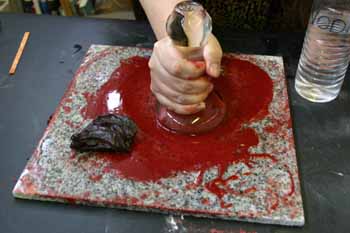

I just updated the website for my book Lapis & Gold: Unlocking the Secrets of Medieval Painters and Illuminators. It's an in depth look into medieval art technique and sacred and spiritual art practices. I hope it will help contemporary artists reclaim the power we’ve lost by relying on industrialized art supplies that pollute our environment and lack longevity. I also hope it will add to the dialogue about art as a spiritual practice. My writing partner, Karen Gorst, is a technical genius. There is so much in this book that has never been put to paper before. I’m really excited about it.I first became interested in illumination during college when I studied at the School of the Sacred Arts at the same time as I was immersed in studying medieval mystics at NYU. It seemed like the perfect art form to me, a marriage of the mystical and material. It is through illumination that I first began to understand the sacred and healing nature of making art. For many years, I strictly adhered to illumination technique:
The Binding of Isaac (Click image for larger view)
Now I just incorporate the techniques. I still make my own art supplies where I can but not always and I often work on paper instead of parchment. My work, however, is still true to the core values of the illumination technique: trust in process, trust in materials, and connection to the Divine. As Above, so below; the artist imitates the Divine Artist.I haven’t written much about my book here because I’ve been on an unplanned, life-enforced break. It had to be set it aside to help my husband close down his business in 2006 and then I had my heart episode/awakening and then our big move which caused my life to unravel into the chaos from which new things are built. I have, however, talked about many of the same themes of spirituality and have touched on technique in a few posts (see Finding the Sacred in Contemporary Art).I hope Lapis & Gold will appeal to a wide range of people. It has information for artists, art historians, spiritual seekers, conservators, medievalists and students of religion. Each chapter has technical information, ancient recipes tested and refined for contemporary use, history, and spirituality. (Click the links for chapter table of contents).
Supports: Paper and Parchment
Ink CalligraphyGilding
Pigments and Pigment Making
The Pigment Almanac (A reference guide to pigments)
PaintmakingProjects
A list of appendices
Here a sample of the types of information you will find in different chapters: the pigment chapter has detailed recipes, lightfastness & pigment interaction testing, and an in depth look at the alchemists who developed these recipes, their spiritual belief systems and how those believes manifest as you actually make each recipe; the calligraphy chapter has, among other things, directions for 3 writing styles, calligraphy as meditation, letter mysticism is the Christian, Judaic & Islamic traditions and the analysis of a medieval page to understand layout.So now finally the time is right to begin again on the journey that is my book. The writing in finished. Lapis & Gold has ripened* on the vine & is waiting for a hungry publisher to come and pluck it. Any advice, contacts, or help you could offer would be greatly appreciated!Thank you and bless you! Sybil* Upon rereading this, I was amused to find that I had unconsciously used the same metaphor as medieval alchemists who sometimes referred to the metals in their chemical reactions as ripening.

The greatest spiritual crisis facing humanity today is rectifying our relationship to the Earth. Sadly, our culture has taught us that physicality and spirituality are incompatible. Thomas Berry, an amazing contemporary theologian, describes our collective state like this:
The earth process has been generally ignored by the religious-spiritual currents of the West. Our alienation goes so deep that it is beyond our conscious mode of awareness. While there are tributes to the earth in the scriptures and in Christian liturgy, there is a tendency to see the earth as a seductive reality, which brought about alienation from God in the agricultural peoples of the Near East. Earth worship was the ultimate idolatry, the cause of the Fall, and thereby the cause of sacrificial redemption by divine personality. Thus, too, the Christian sense of being crucified to the world and living only for the savior. This personal savior orientation has led to an interpersonal devotionalism that quite easily dispenses with earth except as a convenient support for life.

My interest in spirituality and mysticism lies primarily in the via negativa. I’m here to tell you that the via negativa and physicality, the Earth, are compatible. In fact they are integral to one another.The mystic who embraces the via negativa tells us that God is unknowable, greater than anything our mind can conceive. We must therefor remove our mind from the equation, releasing all our ‘ideas’ of God and surrender our need to control. We must surrender any limits that our small minds might place on the unlimited Divine. We must not even will to will ‘God’s’ will.Because this path often requires a withdrawal in silence, it is falsely thought of as an escape from the world. It is not an escape from material reality; rather, it is a complete surrender into it. God and material reality, our Earth, are inseparable. Naturalist John Muir, though not a practitioner of the via negativa can still help us begin to understand the fundamental link between Earth and God.
These blessed mountains are so compactly filled with God's beauty,no petty personal hope or experience has room to be . . . . the wholebody seems to feel beauty when exposed to it as it feels the campfireor sunshine, entering not by the eyes alone, but equally through allone's flesh like radiant heat, making a passionate ecstatic pleasureglow not explainable. One's body then seems homogeneousthroughout, sound as a crystal.- John Muir
The Franciscan mystic Bonaventure (13th century) described all of creation as a vestige, a footprint, of God. Plotinus (3rd century CE) tells us that God emanates form, creation, without ceasing. Eckhart (14th century) describes God as self-generating, creating without cease. He believes that there was a sort of womb of God which he calls “the Abyss of God” which “… remains forever unique, uniform, and self-generating.” The practitioner of the via negativa seeks entrance to this womb, but it is with the understanding that they will not stay there in the place of no thing, they cannot. This womb is a place of constant birthing, of constant creation. By returning to this place, the mystic is “decreated” (see Tauler) and created at once. There is nothing that is created that is not the Divine. Sufi mystic Sheikh Nur Al Jerrahi (Lex Hixon) of blessed memory, puts this beautifully:
The heart is the spring at the center of a clearing within the uncharted forest of creation. Here, what is human, irradiated by Divine Love, transforms into what is Divine. There is nothing other than perfect humanity-which is simply the conscious realization that God alone exits. (p.372)

God alone exists, thus Earth, rain, illness, grass, everything is God. Eckhart also confirms this view: “Ego, the word ‘I’ is proper to no one but God alone in his uniqueness.”If God alone exists, that means that everything that is is God, Being. Thus we do a deep disservice to ourselves and to God by denying our relationship to the Earth. As Thomas Berry says,” Not to recognize the spirituality of the earth is to indicate a radical lack of spiritual perception in ourselves.” Berry goes on the say that:
We need to understand that the earth acts in all that acts upon the earth. The earth is acting in us whenever we act. In and through the earth spiritual energy is present. This spiritual energy emerges in the total complex of earth functions. Each form of life is integrated with every other life form.

Our very spiritual nature is dependant on our embrace of the Earth. By denying it, we deny ourselves and the Divine. Hildegard of Bingen tells us that creation is linked to viriditas, a term which Matthew Fox translates roughly as greening power. Hildegard says that “the word is all verdant greening, all creativity.” Hildegard understands that God is fundamentally creative and the material and the Divine are fused because of the act of creation.
There is no creation that does not have a radiance. Be it greenness or seed, blossom or beauty, it could not be creation without it.

As an artist, the act of creation is especially present for me. But it is there in every moment of every life, not just the artist’s, if we allow it. Humanity has but to step out of the way and let the unceasing creativity of the Divine flow though us. Stepping out of the way means letting go of control. Period. We cannot say ‘I’ll let God direct my life” while still draining and destroying the Earth, because God is the Earth. God is alone, there is nothing which is not God. While we fight for control of our planet, we dam up the joyous flow of Light and Creativity into the world. For us to become “all verdant and greening” we need do nothing but accept what is, our physicality and deep spiritual connection to the Earth. I leave you with the words of biologist Elisabet Sahtouris who has worked to heal the divide between science and religion:
Our human task now is to wake up and recognize ourselves as parts or aspects of God-as-Nature and behave accordingly. All are One, all harm harms each of us, all blessings bless each of us.[Speaking to a congregation] I urged them to occasionally see themselves as the creative edge of God (a phrase I learned from a dear friend) -- as God looking out through their eyes, acting through their hands, walking on their feet, and to observe how that changed things for them…
Note: Over the next few weeks I will be adding a page to this site entitled Earth, with more views and resources on this line of thinking.
 So I started & finished Alex Grey’s The Mission of Art today. I was very impressed. He really understands art as a spiritual path and articulates well the mystical experience inherent is creation. In fact I have been completely converted to Grey’s work as an artist.
So I started & finished Alex Grey’s The Mission of Art today. I was very impressed. He really understands art as a spiritual path and articulates well the mystical experience inherent is creation. In fact I have been completely converted to Grey’s work as an artist.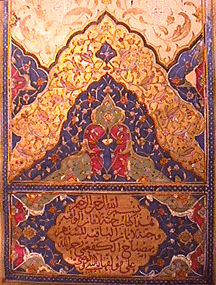 Grey’s work is so luminous it’s almost difficult for me to look at sometimes. Strangely, I’ve always considered him as part of the school of realism. His work has that quality even though he depicts the spiritual body and in his book he often references Michelangelo as inspiration. I’m not too fond of realism although I appreciate the skill needed to do it. But I’ve misjudged. Grey’s work is more like the Islamic Illuminated borders I’ve worked on (See image on left- an authentic 18th cent. Arabic illuminated page). It embodies sacred geometry. When the mind engages with sacred geometry it is elevated and expanded in a particular way. It engages us without going through the feeling body. Much of western art is about emotion and the heart. It is a more Eastern approach to spirituality to travel to God through the Divine mind. Grey’s work engages us in a mystical experience even if our emotions miss it our spiritual body does not.I must say I am wowed by the possibility Grey’s book & work present of healing and transforming humanity through art. This has always been my own desire and unspoken goal. I think it takes great courage to articulate such a lofty goal. I’ll have more posts coming up about this book once I’ve digested it a bit more…
Grey’s work is so luminous it’s almost difficult for me to look at sometimes. Strangely, I’ve always considered him as part of the school of realism. His work has that quality even though he depicts the spiritual body and in his book he often references Michelangelo as inspiration. I’m not too fond of realism although I appreciate the skill needed to do it. But I’ve misjudged. Grey’s work is more like the Islamic Illuminated borders I’ve worked on (See image on left- an authentic 18th cent. Arabic illuminated page). It embodies sacred geometry. When the mind engages with sacred geometry it is elevated and expanded in a particular way. It engages us without going through the feeling body. Much of western art is about emotion and the heart. It is a more Eastern approach to spirituality to travel to God through the Divine mind. Grey’s work engages us in a mystical experience even if our emotions miss it our spiritual body does not.I must say I am wowed by the possibility Grey’s book & work present of healing and transforming humanity through art. This has always been my own desire and unspoken goal. I think it takes great courage to articulate such a lofty goal. I’ll have more posts coming up about this book once I’ve digested it a bit more…


Looking Inside by Sybil Archibald
Today I was thinking about how to define what makes a art work spiritual. As I’ve said before, spirituality in art has nothing to do with the content of a piece. You could pack 100 angels and 20 crucifixions into a painting and that wouldn’t necessary mean it's spiritual or sacred. Spirituality is not about thinking. (One might ask why blog then… but that’s a topic for another post!) You can think rationally about what your idea of spirituality is and perhaps you will paint an angel. But that angel will never be spiritual if you have not touched God in your creative process. I don’t mean artists have to have be full-time mystics, but I they do have to enter into Divine mystery and be transformed.I'd like to use illumination to explain what the sacred in art means to me. When most people think of illumination, they think of medieval manuscripts which have traditionally spiritual images. But it’s not the images that make them holy, it’s the process. I will describe two examples:
1) Gilding: Gilding is the process of adhering a thin sheet of gold leaf to a panel, parchment or other painting surface. First the artist applies gesso which a paste made basically of clay and glue. Because the gold leaf is so thin, applying it to this wet surface would cause the gesso to seep up through the microscopic holes in the gold, dulling its shine. So the gesso is allowed to dry and then its glue reactivated by breathing deeply upon it. This gesso is likened the clay from which the Divine formed Adam the first man. When the artist breathes, it symbolizes the Divine blowing the breath of life into Adam.Gilding is not easy. It requires the proper deep diaphragmatic breath or it will not work. To create this breath, the artist must achieve a calm focused meditative state. The symbolism of Divine creation, becomes more that a symbol. It is a road map telling the artist to tap the Divine well of creativity from which everything comes. The artist must release the self, to tap the Self. This is the transformation I speak about when I say something is spiritual art.

2) My next example is my experience working on my Binding of Isaac piece (pictured to the right). Again, another traditionally spiritual image made spiritual through process not content. It has an Islamic-style illuminated border. These borders are steeped in sacred geometry, in God as Divine Intellect. While I was painting this piece, and the same with other pieces I’ve done using those borders as inspiration, I felt my mind elevated. It is somewhat difficult to explain this. It was almost as it my mind was being pulled up, expanded. I felt larger was I completed this piece. There was more space inside me to accept the world into. This piece transformed me, increase my ability to love. It is the artist’s transformation that is the key to spiritual work.This type of spirituality is built into the long tradition of manuscript illumination, icon painting and other sacred arts. But all art has the potential to be sacred if, as artists, we approach our process as part of our own spiritual journey.
Update: For more on art technique & spirituality check my book Lapis & Gold: Unlocking the secrets of Medieval Painters & Illuminators.
Princess Haiku mentioned Kandinsky's book on her blog and it got me thinking. Most of what the book says has no interest for me, except this:
But to a more sensitive soul the effect of colours is deeper and intensely moving. And so we come to the second main result of looking at colours: their psychic effect. They produce a corresponding spiritual vibration, and it is only as a step towards the spiritual vibration that the elementary physical impression is of importance. (p. 24, 1977 ed.)
I have always believed this. Artwork can create spiritual changes within a viewer and these changes have little to do with a piece's imagery or visual impact. But I would go further than Kandinsky. It's not just color that holds a spiritual vibration, it is the entire physical matter of the painting that can resonate. The physical materials of artwork capture the spiritual vibration of the artist.If an artist struggle with their work, they are really confronting the blocks they have to connecting to the Divine flow, the source of all creativity. When an artist sticks with it and is present to the block for long enough, no matter how difficult or painful that might be, that block will crumble and the artist will undergo a spiritual transformation. The energy from that transformation becomes embedded in their art. This energy then has the potential to resonate with and heal others.When I was practicing the art of illumination, I discovered creating art that effects on a vibrational level can go even further. Illumination was a sacred art in the medieval period. A major component of this art was the creation of art materials. By making art materials in a peaceful meditative state artists can create works of art that literally resonate with healing energies.

The question as asked in Gloria Dean's Blog is interesting to think about, but I believe this is question misses the true point of making art. Art is not about our own assessments of good and bad, it's about the work's relationship to world and its viewers. It is next to impossible for an artist to judge the true purpose or quality of their own work.
Case in point, several years ago I painted a piece about the Binding of Isaac. It is the moment Isaac hands are bound by his father for his sacrifice. The decision to paint the rope tying around his hands as actual Hebrew words from the Bible was automatic. I went through a period of illness, the painting lay abandoned, then judged by me as not so hot. Some time later I had the painting in a gallery and a woman in a wheelchair came in. She was in an almost reclining position. She had oxygen pumped to her nose, and she seem to only have movement in her arms and head. Her wheelchair was electric and she was determined to get into the gallery by herself. She wasn't going to be bound by her illness. I watched her struggle as she finally made it in, immediately drawn to my painting. I could see something in her body language shift as she looked at it.She told me part of her story: she was an ultra-orthodox Jew who had left her faith. Something out the Hebrew lettering and the image spoke to her about her illness. I don't think I've ever had someone understand my own work on a level so much deeper than my own understanding before. By seeing her reaction I received new meaning for the painting which helped me understand my own illness. Clearly, I had made this work for her and never known it. She said it helped to ease her. Sometimes we must surrender to our bonds to achieve freedom.By judging our own work & keeping locked away, we not only block ourselves but block the Divine. Our paintings and works of art can be portals for the creative flow of healing energy into the world. If we are truly creating, it's not coming from us, but through us. We are the filter through which light can pour. A filter is necessary for otherwise, the light would blind us. This is an awesome gift and responsibility- the responsibility not to judge. Even a piece, which by traditional artistic standards may not be great, may have a greater purpose. We don't and can't know. It's up to use to be humble enough to allow the process to work through us.